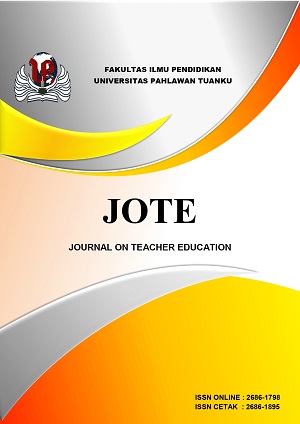Pendampingan Optimasi Daerah Resapan Guna Menangani Genangan di Kota Bojonegoro
Abstract
Keywords
Full Text:
PDFReferences
Badan Meteorologi Klimatologi dan Geofisika. (2022). Informasi Iklim Indonesia Tahun 2022. BMKG.
Bappenas. (2020). Kajian Risiko dan Adaptasi Perubahan Iklim di Perkotaan. Kementerian PPN/Bappenas.
Giordano, R., Pluchinotta, I., Pagano, A., & Pengal, P. (2020). Nature-based solutions for hydro-meteorological risk reduction: A review of governance and implementation challenges. Environmental Science & Policy, 110, 1–11. https://doi.org/10.1016/j.envsci.2020.05.003
Harahap, M. R., & Yuliana, R. (2022). Formulasi Kebijakan Infrastruktur Hijau dalam Pengelolaan Genangan Perkotaan Berkelanjutan. Jurnal Perencanaan Wilayah dan Kota, 17(1), 23–34. https://doi.org/10.21776/ub.jpwk.2022.017.1.3
Hidayati, N., & Purnamasari, E. (2021). Efektivitas Sumur Resapan dalam Mitigasi Genangan Air di Perkotaan. Jurnal Infrastruktur dan Lingkungan, 9(2), 145–157. https://doi.org/10.22146/jil.v9i2.2021
Indriani, R., Fajarwati, L., & Putra, A. G. (2024). Optimasi Daerah Resapan Guna Menangani Genangan. Penerbit Kampus Hijau.
IPCC. (2021). Sixth Assessment Report: Impacts, Adaptation and Vulnerability. Intergovernmental Panel on Climate Change.
Iwan, R., Pradana, A. A., & Nurfadillah, A. (2021). Implementasi Sumur Resapan sebagai Infrastruktur Hijau dalam Menanggulangi Genangan Air di Perkotaan. Jurnal Infrastruktur Lingkungan, 9(2), 113–122. https://doi.org/10.32734/jil.v9i2.12345
Marfai, M. A., & Hizbaron, D. R. (2014). Urban Flood Risk Management: Lessons Learned from Jakarta. Procedia - Social and Behavioral Sciences, 135, 386–395.
Pradana, A. D., & Yuliastuti, N. (2019). Perencanaan Infrastruktur Hijau Berbasis SIG di Kawasan Perkotaan. Jurnal Tata Kota dan Daerah, 11(3), 203–215. https://doi.org/10.23917/jtkd.v11i3.2019
Putri, M. D., & Nugroho, A. S. (2023). Pendekatan Nature-Based Solutions dalam Perencanaan Kota Tangguh Iklim. Jurnal Riset Perkotaan, 8(2), 54–67. https://doi.org/10.20476/jrp.v8i2.2023
Rahmayanti, F., Siregar, F., & Andriyani, R. (2023). Analisis Kesiapan Masyarakat dalam Implementasi Nature-Based Solutions untuk Mitigasi Banjir Lokal. Jurnal Perencanaan Wilayah dan Kota, 18(1), 51–62.
Rizal, M. F., Wibowo, B., & Fatmawati, N. (2021). Pemetaan Partisipatif untuk Identifikasi Zona Resapan Prioritas dalam Penanggulangan Banjir Kota. Jurnal Tata Ruang dan Lingkungan, 13(2), 112–125. https://doi.org/10.23917/jtrl.v13i2.2021
Sagala, S., et al. (2018). The Role of Local Government in Mainstreaming Climate Change Adaptation in Indonesia. Climate and Development, 10(5), 471–482. https://doi.org/10.1080/17565529.2017.1291403
Setiawan, A., Nugroho, P., & Wulandari, S. (2020). Strategi Partisipatif dalam Perencanaan Lingkungan Berkelanjutan. Jurnal Pemberdayaan Masyarakat, 5(1), 33–45. https://doi.org/10.33005/jpm.v5i1.2020
Sutrisno, E., Rachmawati, Y., & Anindita, R. (2022). Pemodelan SWMM untuk Perencanaan Boezem di Wilayah Rawan Banjir. Jurnal Teknik Sipil dan Lingkungan, 10(4), 321–334. https://doi.org/10.31284/jtsl.v10i4.2022
Wulandari, A. D., Handoko, T., & Sutrisno, A. (2020). Model Prediktif untuk Desain Infrastruktur Resapan Menggunakan EPA-SWMM. Jurnal Hidrologi Tropis, 9(1), 44–59. https://doi.org/10.31295/jht.v9n1.2020
Yulianur, Y., Sari, D. K., & Putra, R. M. (2021). Evaluasi Kapasitas Resapan Air di Kawasan Perkotaan Menggunakan Pendekatan Spasial. Jurnal Teknik Sipil dan Lingkungan, 7(1), 23–30. https://doi.org/10.14710/jtsl.7.1.23-30
DOI: https://doi.org/10.31004/abdira.v5i4.956
Refbacks
- There are currently no refbacks.
Copyright (c) 2025 Yulia Indriani, Zainuddin Zainuddin, Levinta Marrietha Utomo Putri

This work is licensed under a Creative Commons Attribution-ShareAlike 4.0 International License.





1.png)
